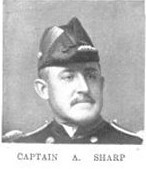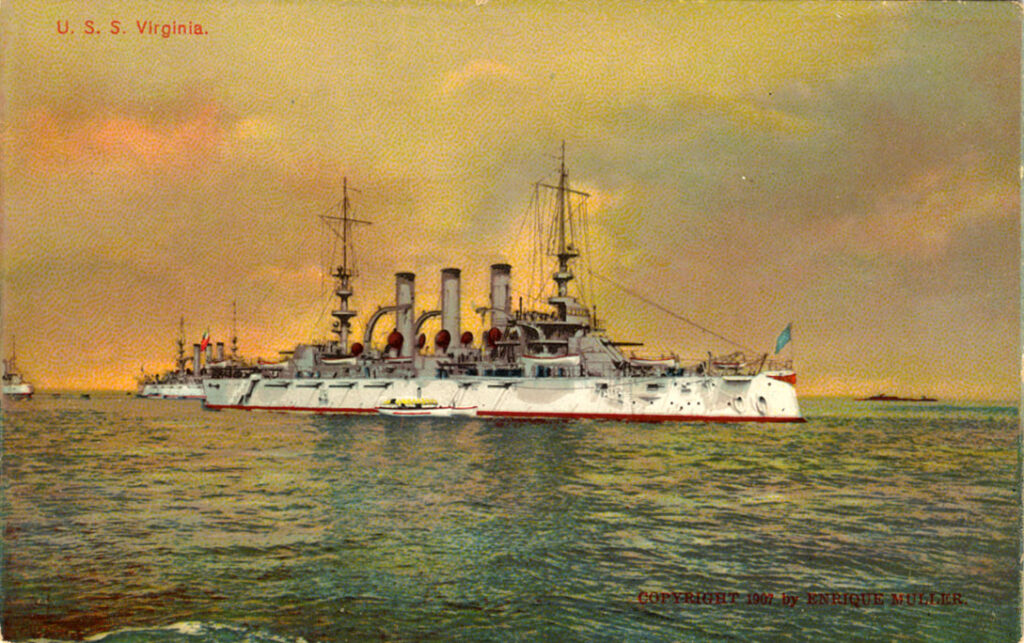Apologies, but no results were found for the requested archive. Perhaps searching will help find a related post.
captains of the fleet
- Captain Osterhaus, USS Connecticut (flagship)
- Captain Vreeland, USS Kansas
- Captain Hubbard, USS Minnesota
- Captain Potter, USS Vermont
- Captain Wainwright, USS Louisiana
- Captain McCrea, USS Georgia (flagship)
- Captain Nicholson, USS Nebraska
- Captain Southerland, USS New Jersey
- Captain Murdock, USS Rhode Island
- Captain Schroeder, USS Virginia
- Captain Niles, USS Louisiana (flagship)
- Captain Sharp, USS Virginia
- Captain Merriam, USS Missouri
- Captain Bartlett, USS Ohio
- Captain Beatty, USS Wisconsin
- Captain Bowyer, USS Illinois
- Captain Hutchins, USS Kearsarge
- Captain Cowles, USS Kentucky
- Captain Harber, USS Maine
- Captain Veeder, USS Alabama
- Captain Qualtrough, USS Georgia
- Captain Doyle, USS Missouri
- Captain Fletcher, USS Vermont
- Captain Howard, USS Ohio
Alexander Sharp, Jr., born in Missouri in 1855, was the son of a navy paymaster and the nephew of Civil War general and president, U.S. Grant. Sharp entered the Naval Academy at Annapolis in June of 1870, being appointed from the District of Columbia.
On May 11, 1873, Sharp was promoted to midshipman, to ensign on July 18, 1876 and then to master on April 8, 1882. It was not until March 3, 1883 that he was finally advanced to rank of lieutenant, junior grade, having been in the navy for over 13 years. This was the rank he would still hold at the time of the Spanish American War. On October 29, 1884, Sharp married Miss Josephine “Josie” Hand in Yankton, South Dakota.
In the year prior to the Spanish American War, Sharp was assigned to the Office of the Assistant Secretary of the Navy, Theodore Roosevelt. Roosevelt described him in his autobiography as being a “first-class fellow.” Before Roosevelt left to join the 1st U.S. Volunteer Cavalry (the “Rough Riders”), he had Sharp appointed to the command of the U.S.S. VIXEN. Later, when Roosevelt’s Rough Riders approached the shore at the Daiquiri landing point aboard the Army transport YUCATAN, by chance, the VIXEN was present. Sharp provided the YUCATAN with a pilot that got the ship close into shore, unlike many of the other transports who had no pilots.
The U.S.S. VIXEN was a formerly the yacht JOSEPHINE which had been armed as a patrol boat. She was 182 feet long, displaced 806 tons and mounted four six-pounders and four one-pounders. During Spanish American War she operated on the Cuban blockade, carrying messages, ferrying prisoners, carrying communications between vessels and communicating with Cuban insurgents. She took part in the bombardments of Santiago between June 13 and June 17.
During the Battle of Santiago on July 3, 1898, the VIXEN was involved, but generally as an observer. She was not within range to use her own guns, but did get fired on by the Spanish vessels. She very briefly engaged the VIZCAYA before that vessel surrendered.
Very shortly after the war’s fighting ended and armistice was agreed to between the U.S. and Spain, Sharp was promoted to lieutenant in August of 1898. Following the war, Sharp, promoted to lieutenant commander, served aboard the venerable U.S.S. HARTFORD of Civil War fame. Later, he was called to testify at the investigation into the actions of Winfield Scott Schley at Santiago.
During the world cruise of the American battle fleet, later called the “Great White Fleet,” from 1907 to 1909, Sharp accompanied the fleet. After the fleet arrived in San Francisco, California, and was preparing to set out across the Pacific Ocean, Captain Sharp was ordered to command the battleship U.S.S. VIRGINIA, succeeding Capt. Seaton Schroeder. Sharp commanded the vessel for the remainder of the cruise. Schroeder commented “I could only find comfort and pleasure in the assurance of the ship being in able hands.” Sharp noted that he found the VIRGINIA to be “…in the way of organization and efficiency, to be about as near perfection as it is possible for ship to be.”
Capt. Sharp returned to the U.S. with the fleet in 1909. Unfortunately, he died on February 9, 1910. Josephine survived until 1932. Capt. Sharp and his wife were buried at Arlington National Cemetery.
Sharp’s son and namesake went on to serve as a vice admiral in the U.S. Navy.


